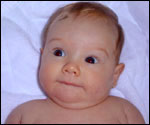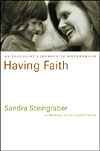I am an environmental activist, and for almost a year, my husband and I have struggled to understand how our environmental commitments bear on our decision about whether to have children. So when I picked up Sandra Steingraber’s new book Having Faith: An Ecologist’s Journey to Motherhood,, I was immediately drawn in by the opening sentence: “Every woman who becomes pregnant brings to the experience her various identities.”
In Having Faith, Steingraber weaves together her own identity as an ecologist and her experience of pregnancy and nursing with data from case studies, birth defect registries, and lab tests. The result is an absorbing book that bridges what Steingraber calls “the disconnect between what we know scientifically and what is presented to pregnant women seeking knowledge about prenatal life.”
Having Faith is a welcome addition to the small but growing body of environmental literature about parenting. Bill McKibben’s Maybe One: A Case for Smaller Families explores the consequences for children and their families of an ecologically-based choice to have just one child. In Hunting for Hope: A Father’s Journey,, Scott Russell Sanders describes the future he would like to help create so that his 17-year-old son can face life with confidence and his newly married daughter can choose to have a child. Like the act of childbearing itself, these books embody deep faith in the future — in our ability to create a world worthy of our children.
Unlike either of those books, Having Faith is written by a woman — a salient difference, in this case, because it allows Steingraber to incorporate first-hand experience into her work. Because of her background in ecology, Steingraber went into her pregnancy asking the kinds of questions other mothers-to-be generally do not: “How do toxic chemicals cross the tough sponge of the placenta? How do they find their way into amniotic fluid? How do they enter the milk-making globes in the back of the breast? What are the effects for the child of these earliest encounters with synthetic chemicals?” These were exactly the questions that interested me as a prospective parent — and Steingraber’s answers filled me with both horror and hope.
The first nine chapters of Having Faith correspond to the months of pregnancy and examine the effects of environmental contamination at each stage. In these chapters, Steingraber repeats the tales that should have alerted us once and for all to the terrible damage that can be done to a fetus by outside agents — thalidomide, mercury, the synthetic hormone DES. She mines these stories for lessons: Fetuses are more susceptible to toxics than adults; some toxics may be “unsafe at any dosage”; the timing of the exposure may be more important than the amount.
In an ironic twist on the eco-feminist notion that the world is reflected in a woman’s womb, Steingraber notes that whatever is in the Earth’s water is in her uterus. Although only one study has ever been conducted on environmental contamination in amniotic fluid (and although that study was not very extensive), its results were alarming: Detectable levels of organochlorine compounds were found in one-third of the 30 samples tested. The amniotic fluid, which plays a key role in developing fetal immune systems, was also contaminated with immune-suppressing PCBs. DDT, known to interfere with sex hormone functioning, was found in concentrations equivalent to the fetus’s own sex hormones.
Toxic chemicals are also found in breast milk, and in the second part of the book, Steingraber shifts her focus from pregnancy to nursing. Based on both scientific data and her own experiences, she weighs the pros and cons of breast feeding versus bottle feeding. Steingraber points out that breast milk is the most contaminated food people consume during their lifetimes; hence it is babies, not adults, who receive the highest concentrations of persistent organic pollutants (POPs), chemicals which persist in the environment, bioaccumulate in fat, and are known to be toxic. Although she concludes that the benefits of breast milk still make it the best food for babies, she also explores evidence that contamination may be approaching levels at which the adverse effects of the chemicals outweigh the benefits.
We Shall Not Abstain
One evening as we took a walk, my husband asked me whether Having Faith was affecting my own thinking about the decision to have a child. I shared with him information I had just read that was particularly relevant to our situation: Steingraber’s discussion of studies that found increased risks of birth defects for babies born in agricultural areas, even if the parents did not work in agriculture. That’s us. One study Steingraber cites was conducted fewer than 200 miles from my home, at Lake Rathbun reservoir in south-central Iowa. The reservoir water, like much of Iowa’s surface water, contains high levels of the pesticide atrazine. Researchers found that those who drank water from the reservoir gave birth to babies with elevated rates of missing or abnormally shortened fingers, toes, arms, or legs, and malformations of the urinary and genital tracts, as well as congenital heart problems.

To baby or not to baby?
Photo: Clark Williams-Derry.
“There’s also a seasonal effect,” I told him. “That study documented an increased number of birth defects among babies conceived in agricultural areas in the spring, when pesticide use is highest. So if we’re going to do this, maybe we need to decide soon, or wait until summer.”
He was silent for a moment, then said, “I don’t think we can worry about everything.”
This is precisely Steingraber’s point — as individuals, we can’t worry about everything. Our culture encourages us to believe we can protect ourselves and our babies by what we avoid: by not drinking impure water, not eating fish, not living in Iowa, not conceiving in the spring. It’s a profoundly negative way of thinking, the antithesis of the advice a friend gave us regarding our decision of whether to have a baby: “You have to decide what you’re going to say ‘yes’ to.” Steingraber’s point is precisely that saying no, as individuals, will not protect us. Only a giant cultural “no” to producing these chemicals can permit us as individuals to say “yes” without fear.
And a cultural “no” can be very effective. Steingraber notes that levels of DDT in breast milk have been declining, and a new treaty to ban POPs should cause them to drop even further. She also suggests that mothers have enormous potential political power. In 1999, testifying at a negotiation round for the POPs treaty, Steingraber passed a bottle of her own contaminated breast milk around a spellbound gathering of high-powered politicians. She also envisions pregnant women marching on Washington, singing a new version of an old song, “We shall not abstain.”
As a culture, we can make decisions that protect children’s health. We have done it in the past, and we can do it again. This is the hope that suffuses the book: The “faith” in the title refers not only to Steingraber’s newborn daughter, but also to her vision for a healthier future.



